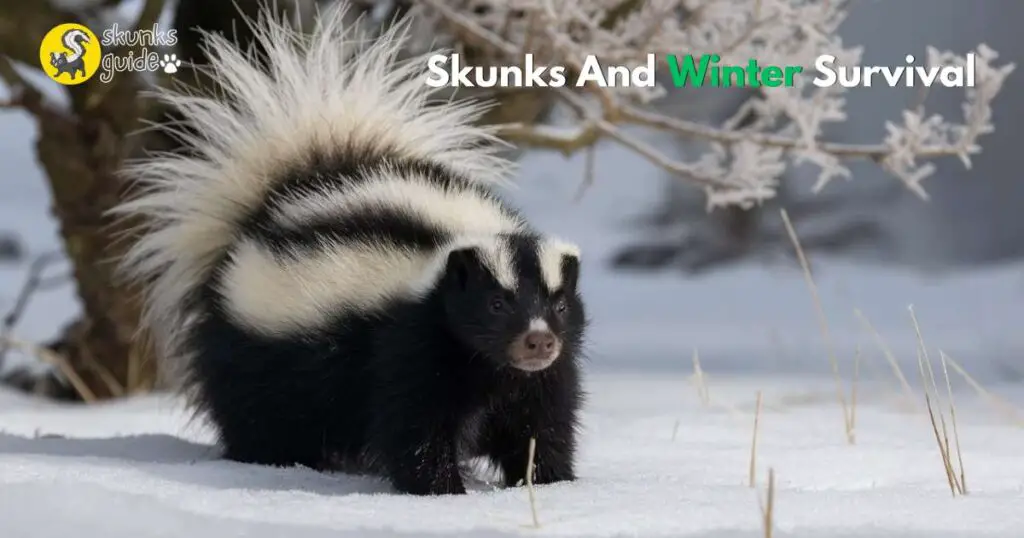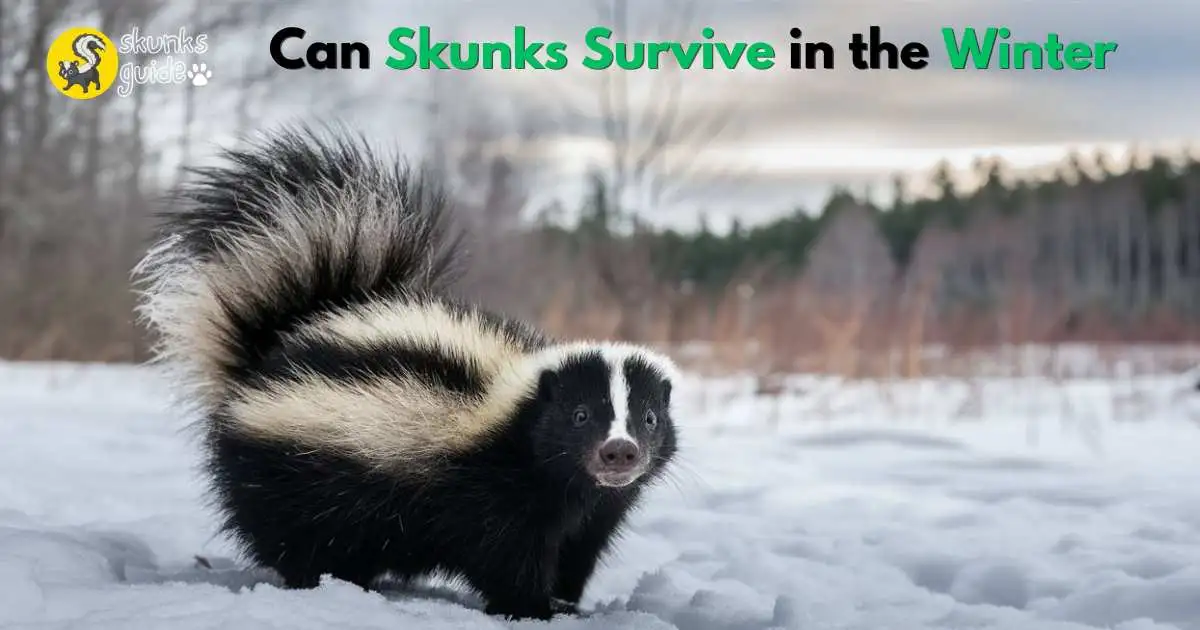Can Skunks Survive in the Winter?
Last updated on September 5th, 2024 at 10:05 am
Skunks can survive in winter, but they do not hibernate. Instead, they enter a state of torpor, slowing their metabolism and reducing activity.
Winter presents unique challenges for wildlife, including skunks. These small mammals adapt by seeking shelter in burrows or underbrush to escape harsh conditions. Skunks typically rely on fat reserves built up during the warmer months. They may venture out on milder days to forage for food, such as insects, fruits, and small rodents.
During particularly cold spells, skunks remain inactive, conserving energy until conditions improve. Understanding how skunks survive winter helps highlight their resilience and adaptability in changing environments. These traits are crucial for their survival in various habitats across North America.
Skunks And Winter Survival
Skunks face unique challenges during winter. They must adapt to cold temperatures and food shortages. Understanding their survival strategies helps us appreciate these fascinating creatures.

Adaptations For The Cold
Skunks have several adaptations that help them survive winter. Their thick fur provides insulation against the cold. They also enter a state of torpor.
- Torpor: A lighter form of hibernation.
- Body Fat: They build fat reserves before winter.
- Denning: Skunks find safe dens to escape harsh weather.
These adaptations help skunks conserve energy. They remain safe from predators and harsh elements.
Food Scarcity Challenges
Winter makes food hard to find for skunks. Insects and fruits are scarce during this season. Skunks are opportunistic eaters and adapt their diet.
| Food Sources | Availability in Winter |
|---|---|
| Insects | Low |
| Fruits | Very Low |
| Small Mammals | Moderate |
| Food Scraps | High |
Skunks often scavenge for food scraps. They dig for roots and bulbs as well. These strategies help them survive until spring.
Hibernation Vs. Torpor
Understanding the differences between hibernation and torpor is essential. Both terms describe how animals survive cold months. Skunks do not hibernate like bears or other mammals. Instead, they enter a state called torpor.
Understanding Torpor
Torpor is a short-term, temporary state of reduced activity. It helps animals conserve energy. During torpor, an animal’s body temperature drops. Heart rate and breathing slow down significantly.
This state can last for hours or days. Animals wake up quickly when the weather improves. Torpor is not as deep as hibernation. It allows for more flexibility in survival.
How Skunks Utilize Torpor
Skunks typically enter torpor during extremely cold weather. They seek shelter in burrows or dense vegetation. Here’s how skunks benefit from torpor:
- Conserves energy during cold spells
- Reduces the need for food
- Allows for quick recovery when conditions improve
Unlike hibernation, skunks can wake up easily. They can forage if the temperature rises. This ability helps skunks adapt to their environment.
Understanding torpor helps us appreciate how skunks survive. Their unique adaptations make them resilient in winter.
Winter Diet Of Skunks
Skunks adapt their diets during the winter months. They face challenges in finding food. Understanding their winter diet helps us appreciate their survival skills.
Foraging Strategies
Skunks use various methods to find food in winter:
- Scent Tracking: Skunks rely on their strong sense of smell.
- Digging: They dig in the snow and soil for hidden food.
- Scavenging: Skunks search for leftover food from other animals.
These strategies help them locate food sources efficiently. Skunks often look for easy meals, reducing energy expenditure. They may visit areas where other animals gather.
Dietary Adjustments
Winter causes skunks to change their diets. They typically eat:
| Food Type | Example |
|---|---|
| Insects | Beetles, grubs |
| Fruits | Fallen apples, berries |
| Small Animals | Mice, voles |
| Vegetation | Roots, tubers |
Skunks may consume more plant matter during cold months. This adjustment helps them maintain energy levels. They also take advantage of any available food sources.
By adapting their foraging techniques, skunks survive the winter. Their ability to change diets showcases their resilience. Observing these creatures can teach us about nature’s balance.
Shelter And Denning Habits
Skunks face harsh winter conditions. They need safe places to stay warm. Understanding their shelter and denning habits helps us know how they survive.
Natural Shelters
Skunks prefer natural shelters for protection. These shelters provide warmth and safety. Some common natural shelters include:
- Hollow logs
- Rock crevices
- Thick underbrush
- Dense grass
- Abandoned burrows from other animals
These places keep skunks safe from cold and predators. They often find these spots in forests or fields. The right shelter helps them conserve energy.
Burrowing Behaviors
Skunks are skilled diggers. They can create their own dens. This behavior is important for winter survival. Here are key facts about their burrowing:
| Burrowing Aspect | Description |
|---|---|
| Depth | Skunk burrows can be about 1 to 3 feet deep. |
| Location | They dig near shrubs or trees for cover. |
| Structure | Burrows often have multiple chambers for resting. |
These burrows trap heat. They create a cozy environment for skunks. Skunks often share these spaces with family members.
Physical And Behavioral Adaptations
Skunks are fascinating creatures that have developed various adaptations to survive winter’s challenges. Their physical and behavioral changes help them cope with cold temperatures and food scarcity. Understanding these adaptations reveals how skunks thrive despite harsh conditions.
Thick Fur Growth
One of the most notable adaptations skunks exhibit is their thick fur growth. This fur acts as a natural insulator. Here are some key points about skunk fur:
- Winter coat: Skunks grow a denser coat in winter.
- Insulation: The fur traps heat close to their bodies.
- Water-resistant: Skunk fur repels moisture, keeping them dry.
This thick fur allows skunks to maintain their body heat during frigid nights. A well-insulated skunk can remain active even in severe cold.
Reduced Activity Levels
Skunks also adapt by reducing their activity levels during winter. This behavioral change helps them conserve energy. Key points include:
- Hibernation-like state: Skunks may enter a torpid state.
- Less foraging: They limit their search for food.
- Burrowing: Skunks often stay in dens to stay warm.
By slowing down, skunks use less energy. They rely on stored fat reserves. This strategy helps them survive until spring.
Reproduction Cycle And Timing
The reproduction cycle of skunks is fascinating. Skunks mate during a specific time each year. Their survival in winter affects their breeding. Understanding their mating habits helps us learn more about these creatures.
Mating Season
Skunks have a defined mating season. This typically occurs in late winter to early spring. The exact timing can vary by species and location. Female skunks attract males through scent. Males may travel long distances to find a mate.
- Mating season: January to March
- Gestation period: 60 to 75 days
- Litters usually consist of 2 to 10 kits
After mating, females prepare for the arrival of kits. They create a den in a safe location. This ensures the kits are protected from predators and the cold.
Impact Of Winter On Reproduction
Winter affects skunk reproduction in various ways. Harsh weather can limit food availability. This impacts female skunks’ health and fertility.
| Factor | Impact on Skunks |
|---|---|
| Cold Temperatures | Reduced energy for reproduction |
| Food Scarcity | Lower fertility rates |
| Predator Activity | Increased risk for pregnant females |
Despite these challenges, skunks adapt well. They may delay reproduction if conditions are poor. This ensures that the kits have a better chance of survival.
Human Interaction And Impact
Human actions greatly affect skunks during the winter months. Understanding these impacts helps us protect wildlife. Skunks face many challenges in urban areas. Their survival often depends on our choices.
Urban Survival
Skunks adapt well to urban environments. They find food and shelter in places like:
- Garbage bins
- Under decks
- In sheds
Urban areas provide warmth and resources. Skunks use human structures for shelter. This adaptation helps them survive harsh winters.
Risks And Threats
Despite their adaptability, skunks face many risks:
| Risk | Description |
|---|---|
| Traffic | Skunks often get hit by cars. |
| Habitat loss | Development reduces their natural homes. |
| Human conflict | People may trap or kill skunks. |
These risks threaten their survival. People can help by:
- Securing trash cans
- Avoiding poison
- Respecting wildlife habitats
By understanding and reducing these threats, we can help skunks thrive in winter.
Conservation And Protection Efforts
Skunks face many challenges in winter. Conservation and protection efforts are vital. These initiatives help skunks survive harsh conditions.
Wildlife Rehabilitation
Wildlife rehabilitation centers play a crucial role. They care for injured or orphaned skunks. These centers provide food, shelter, and medical attention.
Rehabilitated skunks are often released back into the wild. This helps maintain healthy populations.
Key activities in wildlife rehabilitation include:
- Rescue and transport of injured skunks
- Medical treatment and care
- Feeding and nutrition support
- Habitat training for released skunks
Creating Skunk-friendly Habitats
Creating safe habitats is essential for skunk survival. Native plants and natural shelters provide food and protection.
Homeowners can help skunks by:
- Avoiding pesticides and harmful chemicals
- Planting native vegetation
- Providing water sources
- Building brush piles for shelter
Community awareness programs can educate people about skunk conservation. Events like clean-up days encourage habitat restoration.
Frequently Asked Questions
Where Do Skunks Go During The Winter?
Skunks seek shelter during winter in burrows, hollow logs, or under buildings. They enter a state of torpor, reducing activity and conserving energy. This behavior helps them survive cold temperatures and food scarcity until spring arrives.
Do Skunks Come Back To The Same Place Every Year?
Yes, skunks often return to the same areas annually. They tend to use familiar dens and foraging spots, especially if food sources are abundant. This behavior can lead to recurring visits in spring and summer. Keep your yard clean to discourage them from returning.
Do Skunks Come Out In Freezing Weather?
Skunks do venture out in freezing weather, but their activity decreases. They seek shelter in burrows or dens during extreme cold. Foraging for food may still occur, especially if hungry. Skunks adapt to different climates but prefer milder temperatures for their active hours.
Conclusion
Skunks have adapted well to winter conditions. They rely on their thick fur and fat reserves to survive the cold. While they may not hibernate, skunks enter a state of torpor, conserving energy during harsh weather. Understanding their winter habits helps us appreciate these unique creatures in our ecosystem.

